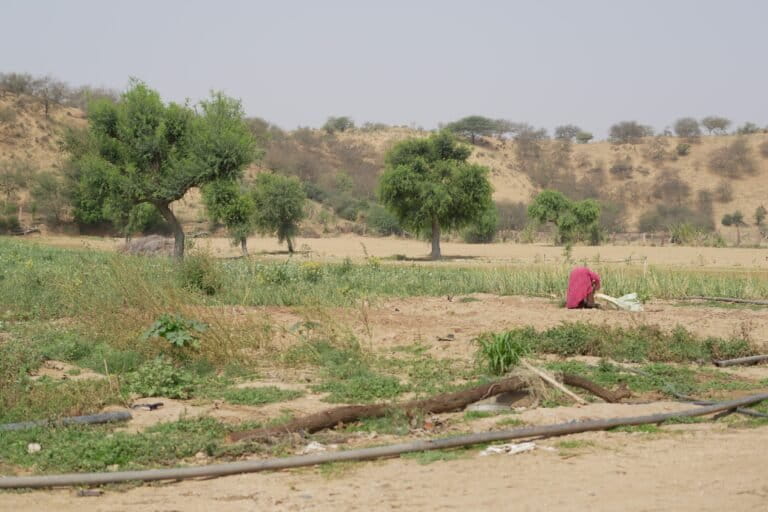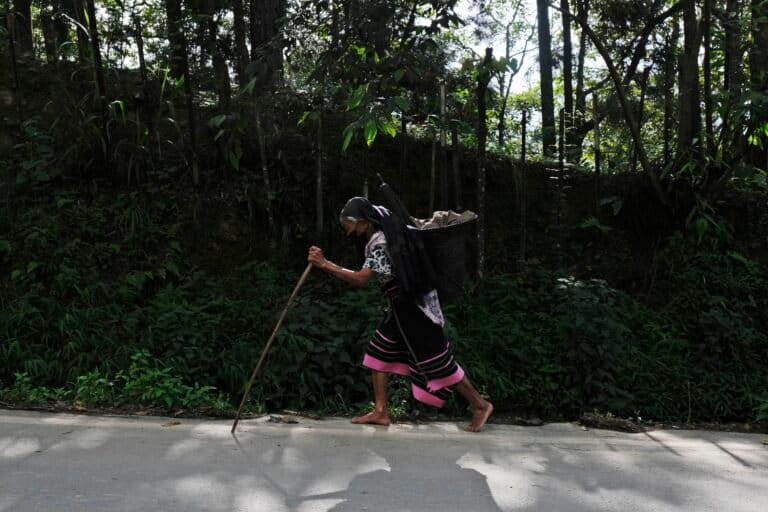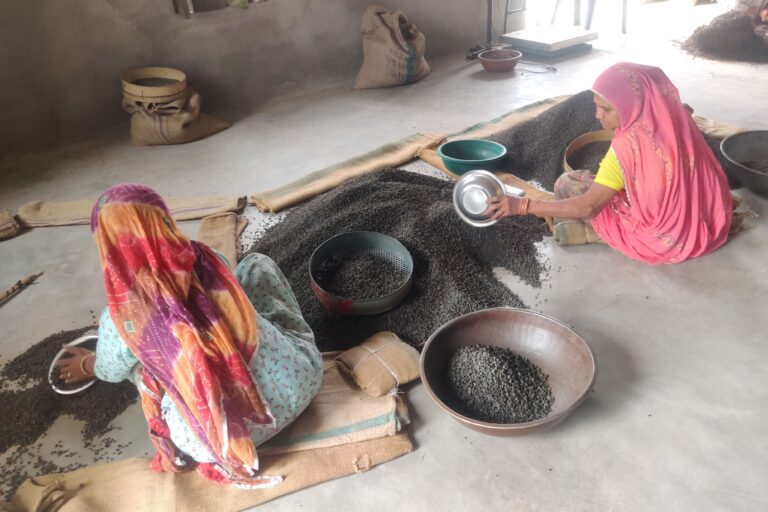- Meghalaya’s living root architecture is testament to the use of traditional knowledge in sustainable living.
- Increased concretisation and tourism are threatening the living root structures.
- Villages are uniting to preserve the architecture and the invaluable knowledge through youth engagement and documentation.
To the outside world, Meghalaya is nature’s wonderland, captivating visitors with its mist-shrouded hills, canyons, valleys, and cascading waterfalls. For the natives living in isolated villages, however, daily life in this dramatic landscape involves navigating steep hillsides and torrential rivers beneath dense, rain-soaked subtropical canopies. To ensure safe connectivity, the ancestors of the Khasi and Jaintia Hills learned to guide the aerial roots of the Ficus elastica (Indian rubber fig tree) to build functional architecture.
The famous living root bridges, evoking images from the set of the Hollywood blockbuster Avatar, have earned a place on UNESCO’s tentative list of World Heritage sites. However, Ficus-based living architecture, known as Jingkieng jri in Khasi language, extends far beyond just the bridges.
Local residents recommend treks that showcase indigenous craftsmanship using Ficus roots, rarely experienced by outsiders. On one such ancient trail in Pynursla, we climbed the intricately woven living root ladders. On the way, we navigated narrow passages carved along the edge of a hillside, where even the slightest misstep could send us plummeting into the depths below, were it not for the natural railings and retaining walls expertly crafted from Ficus roots.

There were also latticed, hammock-like resting platforms suspended from the hillside, entirely woven and supported by Ficus roots, which were particularly intriguing. Our local guide effortlessly climbed onto one, confident in its strength after 15 years of root growth. Surprisingly spacious, the structure can comfortably support five or six adults. He mentioned that newer ones would require over a decade to develop the same strength and resilience.
These living structures have facilitated access for the local residents, to their farmlands and markets, as well as enabled foraging in the forests, ultimately shaping their way of life. Over time, the living root bridges have become a cornerstone of eco-tourism.
Shared stewardship
Living root structures, deeply embedded in local traditions, are primarily community-driven projects. However, their ownership and maintenance vary from village consortia to private individuals.
“Traditionally, in the Khasi matrilineal society, where family names are passed down through women, men over 50 without female siblings or children are preferred to plant Ficus saplings for construction. This ensures their family name is remembered for their contributions,” explains Morningstar Khongthaw, chairman of the Khyrim Syiemship (Kingship) Heritage Committee, which is dedicated to community-led heritage preservation initiatives.
Creating a living root bridge begins by placing young, pliable aerial roots from Ficus elastica into hollowed trunks of Areca catechu, supported by bamboo scaffolding. The trunks provide essential nutrition for the roots and protection from the elements. Initially, two or three long fibers are stretched across a stream or gorge and anchored on the opposite side—either firmly driven into the earth or entwined with the fibers of another Ficus tree. Over the years, additional roots are inosculated into the primary system to create steps and handrails. The bamboo scaffolding, which degrades over time, is periodically replaced. Stones, timber planks, leaves, and soil are added in stages to fill any gaps. Within a few decades, the root structure can support significant weight, eventually standing independently without the bamboo support. Its regenerative qualities make it inherently sustainable.

Regular maintenance of root structures includes removing mosses and epiphytes, pruning and tying roots, laying materials along the path, and clearing the adjacent pathways. The roles are well distributed: men collect the bamboo and handle the heavy tasks, while women are responsible for clearing the area and performing the more intricate work of splitting bamboo culms and creating strips and threads to tie the roots to the bamboo frames.
“Our women are more enterprising. After the morning chores, we venture out to the forest, farmlands and markets, frequenting these living root structures more than the menfolk. We take pride in actively participating in their construction and maintenance,” says middle-aged Montila Khongbeh from Mawkyrnot, another village in Pynursla, as she guides the younger women in the craft. “We call it meiramew, which means ‘the profound act of giving and merging with mother nature’.”
The extended timeframe required for the completion of a root structure necessitates an intergenerational perspective. Hence children and descendants too are actively involved in decision-making.
Roots of resilience
In 2019, 75 living root bridges were mapped by the Technical University of Munich (TUM) revealing lengths of up to 52.7 meters with some aerial roots extending over 30 metres.
In recent times however, many bridges are neglected due to the encroachment of concrete structures. Mapping efforts revealed that some bridges frequented by tourists have been reinforced with concrete or steel components for safety, and the paths leading to them have also been paved. Increased tourism amenities are being constructed around these structures, prompting villages to scale back on farming and generate more income from tourism. Traditional village governance structures for managing the bridges struggle to adapt to these rapid changes.
In response, a silent movement has been brewing among the communities. The Heritage Committee has established a Centre of Knowledge for living root architecture. With support from the United Nations Development Programme, it mapped over 132 living root bridges and has adopted 30 of them in the villages of Rangthylliang, Mawkyrnot, and Mynrieng, for conservation.

“There are about 20 remaining elders in our community who are skilled in living roots architecture. Every monsoon, which is the prime season for weaving the young roots, groups of youths come together to apprentice under them,” Morningstar from Rangthylliang, informs Mongabay India.
New bridges are also being constructed, and for the first time, the entire process is being meticulously documented, integrating both tangible and intangible insights from the vernacular craft. Experts are being consulted to estimate the age of existing bridges. Many structures are shared between villages that have come together to preserve this knowledge. The committee has proposed a 50-metre protected forest, or law adong, around each bridge to prevent any construction that could potentially harm the structures and their supporting ecosystem.
The Meghalaya government is also documenting bridges and developing protection guidelines that are science-backed and community-vetted. However, local stakeholders criticise the “top-down” approach, alleging insufficient participation from indigenous practitioners and an over-reliance on external experts.
Traditional wisdom
This tacit knowledge of crafting marvels without modern engineering tools has sparked interest in studies aimed at advancing regenerative bioengineering. Ferdinand Ludwig, a professor at the Technical University of Munich, has incorporated this knowledge into his pioneering concept of Baubotanik — architecture that utilises living trees as construction materials. This innovation redefines building typologies and the relationship between interior and exterior spaces, city and landscape, nature and culture.
“I am convinced that Ficus-based architecture can play a vital role in making subtropical and tropical cities greener, more biodiverse, resilient, and livable,” Ludwig shares via email. “The function of the living roots in the Khasi bridges is primarily load-bearing. In an urban environment, this allows us to integrate buildings and trees, providing ecological benefits such as shading, cooling, air filtration, and habitat creation.”
To bring the cultural and ecological features of this architecture to urban settings, the architecture departments of TUM and North Eastern Hill University jointly initiated a 5m x 10m living root pavilion on the latter’s campus in Shillong in 2022, coinciding with the 50th anniversary of Meghalaya’s statehood.

The Baubotanik group designed the Arbor Kitchen in Germany which features a grove of 32 London plane trees (Platanus acerifolia), planted in 2012. The grove encircles stone tables and an oven for people to gather and share meals while interacting with the landscape and enjoying the play of natural light through the canopy.
Pori Das, senior assistant professor at Assam Don Bosco University who is researching the implementation of blue-green infrastructure as nature-based solutions mentions that certain species other than Ficus, such as banyan trees, American sycamore, English oak, etc can also be incorporated into living architectural designs.
“Regenerative architecture incorporated in urban spaces surpasses sustainability. It helps in carbon sequestration, climate adaptation through evapotranspiration and shade provision thus reducing ambient temperatures by 2-8°C, managing urban stormwater runoff, and providing health benefits like reducing stress and respiratory illnesses,” Das says.
Ludwig meanwhile highlights that although this approach cannot fully address the construction industry’s emissions problem, as living roots cannot replace high-performance materials like steel, it holds substantial relevance for local climate change adaptation, particularly in carbon sequestration. “Ficus-based living architecture will complement, rather than replace, conventional building materials, he adds.
Read more: Interwoven in the living root bridges are stories of biodiversity and human interactions
Banner image: Khasi women cross a living root bridge at Mawkyrnot, a village in Meghalaya. Image by Barasha Das for Mongabay.














